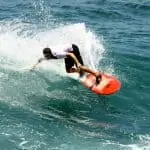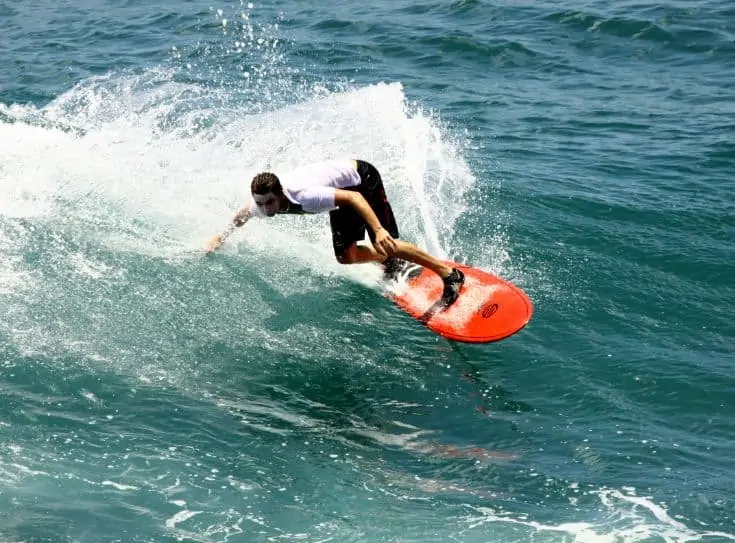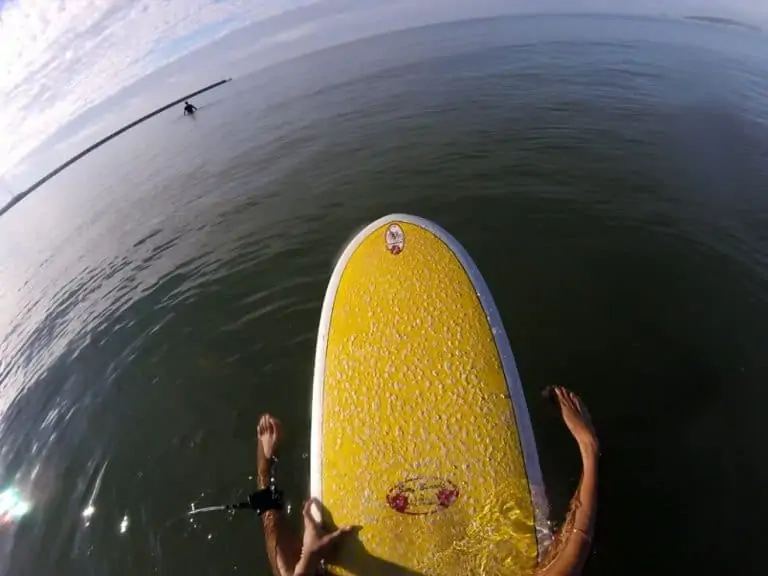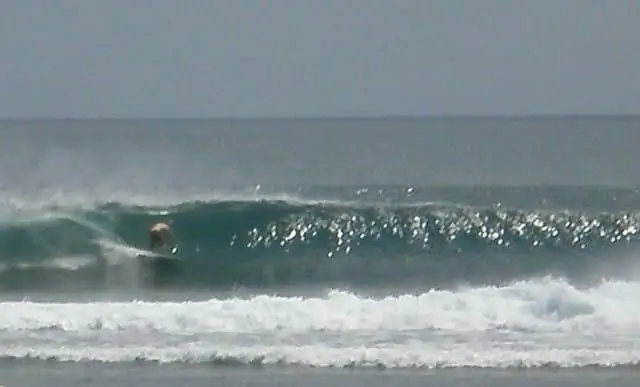12 Tips for How to Learn to Surf Without Water
Learning to surf is a great experience that can help you to improve your health, fitness and wellbeing.
However, there are many more people who want to learn to surf but can’t get to the ocean or coast very often and need some alternative ways to start.
So, here are some tips to help you to start learning to surf without water:
- Practice Your Pop-up at Home
- Practice on a real board
- Watch Surf Videos
- Balance board
- Longboard on Hills
- Hit Swimming Pool with a Special Board
- Learn the etiquette
- Build your surf strength
- Increase your lung capacity
- Read up on surfboards
- Learn about surf forecasts
- Figure out your chosen surf spot
Now, of course, you can’t learn everything about surfing without getting in the water, but with the detailed explanations of the tips above, you should be able to give yourself the absolute best chance of being surf-ready when you finally get to the beach.
So, let’s have a look at each in more detail and explain how you can start learning to surf without water!
Practice Your Pop-up at Home
Popping up on a surfboard is one of the key maneuvers that every surfer needs to master. To be clear, this is when you go from lying down on your surfboard to standing.
This happens at the crucial moment when you catch a wave.
Fortunately, for anyone landlocked, this is a movement that you can start to learn before you get in the sea.
Elements of a Surfing Pop-up
The main thing to know is that this is a combination of fairly straightforward movements.
Here are the key elements of a surfing pop-up:
- After you paddle for a wave, you will need to place your hands flat on the board under your shoulders.
- From there, you will move your shoulders and torso upwards, similar to a yoga move called the cobra.
- When you are fully extended, then it is time to swing your legs forward.
- Try to plant your feet flat on the floor.
- Do not use your knees or drag your feet here.
- Make this as explosive as possible.
- As you plant your feet, also swing your hands and arms forward so that they are out. in front of you – this should give an extra bit of momentum.
- Think about looking to the right or left as you will need to go along a wave, not straight towards the beach.
Practising a Surfing Pop-up at Home
You can practise this on your floor (softer the better), on grass or on a yoga or exercise mat. It’s good to think about the width of a surfboard when doing this since your hands and feet might miss the board if not careful when you do it for real.
Learning with this in mind should help you to start off properly.
As an extra tip, film yourself using your phone when practising your pop-ups to get instant feedback of how you are doing and where you are going wrong.
You should instantly see things that don’t look right and can correct them before they become bad habits.
Practice at Home on a Real Board
If you have a surfboard in your house, you can then take your pop-up to the next level by practising with your board.
Since surfboards are extremely fragile, the best way to do this is with cushions or pillows under the board. You should also have a soft surface like a carpet or yoga mat below you to stop any damage to the board if you fall off.
You will also need to remove the fins from your surfboard as these will break in no time if you don’t! Trying to do this with the fins in the board might also damage the board itself, so take the time to remove them before you do it.
Just be mindful of how you might fall when you do this and try to do it in an open space rather than a tiny room.
If you slip and kick the board, it might hit the wall and ding or crack, which you definitely don’t want!
To make this even more like riding a wave, angle the board so that it is higher at the back – the tilt could help to make it feel a bit more like taking off on the top of a real wave.
The main thing here is to only do this if you feel safe doing it – if you are in doubt, just stick to using the floor or a mat.
Watch Surf Videos
You can learn a lot about surfing from watching videos. I know I was fully hooked on surf videos when I was younger and, at the risk of showing my age, we only had a few VHS video tapes to keep us going!
That said, watching those videos definitely helped me to understand more about surfing and the overall ways that the best surfers ride waves.
So, to help you, here are a couple of pointers and things to look for when trying to learn from surf clips or videos.
General Flow and Movement
You can quickly start to see the general flow and movement involved in surfing from watching a few clips.
One of the most famous waves ever captured on film was from 3 x world surfing champion, Tom Curren.
The footage was captured during a free surfing session at the world-renowned Jeffrey’s Bay surf spot in South Africa by Sonny Miller.
You can see it in the video below, which really shows flawless movement and flowing style that can help surfers to generate maximum speed on a wave.
Now, let’s be sure – this is a professional surfer doing some of the best surfing ever seen, so it’s not something to try to emulate straight away but it does give you a very good guide of what you should think about when you get up on a wave.
Positioning
There are 3 further points about positioning yourself out in the surf that you can get from watching surf clips.
The first is the position on a board. You should notice that surfers are not too far forwards as this will cause them to tip over. They will usually have their shoulders about two-thirds of the way up their board when lying down.
For learner surfboard positioning, watch some clips of longboarding to get a better idea. You can watch the clip below of a surfboard shaper and former world longboarding champion, Josh Constable, as he rides a very fun looking surfboard in small waves.
Look at the aerial shot for how far up he is on his board when paddling and also when he paddles for a wave.
Leading on from the points above, you can see where surfers place their feet on the board. I’d recommend just watching one of the clips above and focusing on their feet only. I know this gave me a new insight into surfing, so should help you, too.
As an additional point, watching surf clips also helps to get an idea of how surfers should position and move their hands and arms when riding a wave. I’d recommend again doing the same thing as above but watching the clip to see where the surfers position their hands and arms throughout the wave.
Sit back, enjoy and take notes!
When Waves Will Break
You can also get a good idea of how a wave will look when it is about to break. One common problem for learner surfers is that they get caught out by waves that break on their
There are also some great videos on YouTube that can help you to learn to surf, like this one by the channel How to Rip:
Look at Take-offs
Again, coming back to learning from videos, try to watch as many surfers taking off on waves as you can.
There are again many good videos on this online, with this one from How to Rip again being really helpful:
You can use this to start to get your head around how your body should move and at exactly what time you might need to take off on the wave.
I’d also suggest watching for the exact hand placement the surfers in these videos use at the time when they take off.
To help you here, watch YouTube videos on this at a slower speed so that you can see the full dynamics of the take-off. A speed of 0.25 works pretty well but you’ll definitely want to put it on mute as the sound is horrible!

From there, you can do all the same points as mentioned above, taking it in turns to focus on things like hand and foot placement, as well as head and shoulder movements.
Balance board
To help you get the balance needed for surfing, you can try using a balance board. These are really popular and are sometimes called ‘Indo Boards’ as this was the first brand that released them commercially.
They are essentially a piece of strong wood with 2 stops on either end that you can roll back and forth on on a hard plastic roller underneath, as you can see in the video below.
These help you to build the needed leg and core strength for surfing, as well as giving you an unpredictable and moving platform to practise balancing on, similar to a moving surfboard.
You can buy a balance board, or, if you like, try making one of your own. Be sure to get the right type of wood otherwise you might have a broken board very quickly!
And again, be careful when using these – they can be tricky to start with and are definitely easy to fall off, so go easy!
Longboard on Hills
Even if you live in land, you can try using a longboard skateboard to practise the movements and flow of surfing.
If you go down gentle hills, you can glide from side to side and get an idea of the balance and movement need to turn a surfboard.
Again, this won’t be exactly like a surfboard, but it gives you some idea of how it might be to surf and is a good bet for practising on dry land.
Make sure you get a quality longboard and only use it on hills that you feel safe on. I have had a few spills on these and, unlike surfing, they really hurt!
You could get some extra padding and protective gear to go with your longboard so that you are not too banged up when it comes to hit the waves for real.
Hit Swimming Pool with a Special Board
Swimming is obviously great exercise but it can also be made more like surfing using a special board for paddling practise.
The new SurfAtom paddleboard has been designed specifically to target paddling muscles and can help surfers to get better and stronger at paddling when they don’t have a beach or waves nearby.
It’s also designed to be taken into pools, so you shouldn’t have too many issues using it in your local swimming pool.
It’s inflatable, too, so there are no worries about storing it, either.
You can see their video explaining the board below for more information
Learn the Etiquette
A key part of learning to surf is also learning how to behave when you are out in the waves, or surfing etiquette as it is often called.
This is because the sea has no defined lines or markings or people to control things, so being aware of others and how to behave is really important.
The main points that you need to learn before hitting the waves are the following:
- Drop-ins
- Take-offs
- Getting out of the way
Drop-ins are when a surfer takes off on a wave that someone else is already riding on or has priority. You should never do this and should be careful to check that nobody is coming before you take off on any waves.
Dropping in on another surfer is not only dangerous but it could make them very angry, so avoid this at all costs.
Take-offs are related to drop-ins and you should not take off on a wave on which another surfer already has stood up on, especially if that surfer is closer to the breaking part of the wave than you.
The last thing to figure out is how to get out of the way of an oncoming surfer. If you see someone coming towards you, you should paddle sideways towards the breaking wave so that they can pass you when they get near.
Build Your Surf Strength
We’ve already talked about doing pop-ups and using a balance board which can help you to build up your surfing strength without a beach or sea, but there are also a few more things that you can do.
Surf Strength Routines
There are lots of surf strength workouts and routines that you can follow online, like this one by the Surf Strength Coach.
These are specific so give you the exact muscles and workouts that you could need.
Once you get your strength up for surfing, it’s then really a question of learning the movements and you should be able to make progress much more quickly.
Bodyweight Routines
This program from AthleanX is similar to the paid version of the program from AthleanX that I have and currently use daily.
Bodyweight workouts are not to be taken lightly and can again massively improve your strength and overall conditioning
Yoga for Surfers
There are also lots of dedicated yoga for surfers routines. I won’t go into all the reasons why yoga can help but the main points are for flexibility and strength.
You can take your pick from the main videos online, with one example below from a popular Yoga for Surfers DVD that was available many years ago
Increase Your Lung Capacity
Having a good lung capacity can really help you in the surf. This means that you can paddle harder and faster for longer.
It will also allow you to feel more confident when a wave pushes you under water, something that will definitely happen.
You can increase your lung capacity through doing many common types of aerobic exercise, like running, jogging or swimming.
Getting a good level of fitness overall will be a massive boost for you when it comes time to hit the waves for real, so just doing this consistently and increasing it over time can really help you when trying to learn to surf without water.
Read up on Surfboards
You should also start to read up about surfboards. You can begin to learn which boards are best for beginners. From there, you can then look at how the different shapes of surfboards affect how they perform in the water.
This will help you to start to figure out the kinds of movements you can and can’t do on each borard. For instance, longer, wider surfboards are great for catching waves but harder to turn. On the flip side, shorter smaller boards are great for doing maneuvers but much harder to paddle on, catch waves and stand up.
If you still need a surfboard, be sure to get the full breakdown of everything you need to know about beginner surfboards in my dedicated guide!
Learn about Surf Forecasts
To help you learn to surf, you can start to identify the right kind of conditions that you will need to get out in the surf on the right day.
You can start by using surf forecasting websites, of which there are plenty to choose from. A good and simple one to start with is MagicSeaweed, which has surf reports and forecasts for spots all over the world.
A tip here would be to look at the conditions forecasted and then compare them to the photos users post on the site. This is because it will say what the conditions were like on that day, so you can start to see when the right day might be for you to make a journey or trip to your desired spot for your chance at really surfing in the sea.
The key factors to look at when reading surf forecasts are wave height, wind conditions and swell.
Another good site is WindGuru, which gives you all kinds of wind forecasts along with wave height forecasts. The wind is key since a strong wind can really kill good waves, so you don’t want to go on those days.
You can again use this information and combine it with some live webcams to see how the surf is in real time.
Figure out Your Chosen Surf Spot
The last thing is for you to figure out the waves and breaks at your chosen surf spot. This should help you to start to learn how the waves break and mentally prepare yourself for heading out there.
A great website for surf webcams is Surfline, although they will ask you to pay after a certain amount of time on some webcams.
Try to figure out the ‘line up’ and look at where most people are sitting, as well as the abilities of the different riders on each part of the break.
You can also look around for local surf schools. Whether you want a lesson or not, this can give you a good idea of the best spots and see when they go out.
Another factor to keep in mind is the tide. Some surf spots will become dangerous or even unsurfable on certain stages of the tide, so start to take notes on this as you watch and learn.
You could also check out the Surf Session Diary that I made over on Amazon. This helps surfers learn and log their conditions, honing their skills at forecasting and predicting conditions for a specific spot.
Final Thoughts on Learning to Surf Without Water
Remember that when you finally get a chance to head into the water to practise all that you’ve learned, you will only need small, calm conditions to learn to surf.
Don’t get too ahead of yourself and try to go when the waves are big – that’s definitely not what you need to learn to surf!
Most of all, stay safe when trying to do any of the things mentioned above and get ready for the rollercoaster that is learning to surf in the ocean – you will have a blast!




